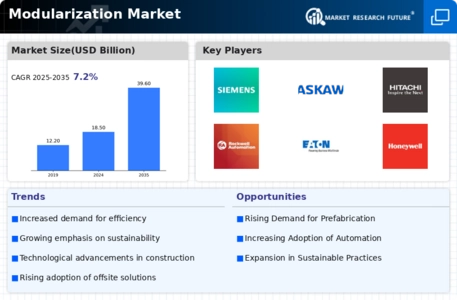Market Growth Projections
The Global Modularization Market Industry is projected to experience substantial growth, with forecasts indicating a market size of 18.5 USD Billion in 2024 and an anticipated increase to 39.6 USD Billion by 2035. This growth trajectory suggests a robust compound annual growth rate (CAGR) of 7.17% from 2025 to 2035. Such projections reflect the increasing acceptance of modular construction across various sectors, including residential, commercial, and industrial applications. The market's expansion is likely to be driven by factors such as technological advancements, sustainability initiatives, and government support.
Government Initiatives and Support
Government initiatives significantly influence the Global Modularization Market Industry by promoting modular construction through policies and incentives. Many governments recognize the potential of modularization to address housing shortages and improve infrastructure efficiency. Programs that support research and development in modular technologies, as well as financial incentives for adopting these methods, are becoming increasingly common. Such initiatives not only stimulate market growth but also encourage collaboration between public and private sectors. As governments continue to invest in modular solutions, the market is poised for sustained expansion.
Technological Advancements in Construction
Technological advancements play a crucial role in shaping the Global Modularization Market Industry. Innovations such as Building Information Modeling (BIM) and advanced manufacturing techniques facilitate the design and production of modular components. These technologies enhance precision, reduce errors, and streamline the construction process. Furthermore, the integration of smart technologies into modular units allows for improved functionality and energy management. As these technologies continue to evolve, they are expected to drive further adoption of modular construction, contributing to a projected CAGR of 7.17% from 2025 to 2035.
Increased Demand for Prefabricated Solutions
The Global Modularization Market Industry experiences a surge in demand for prefabricated solutions, driven by the need for faster construction timelines and cost efficiency. Prefabrication allows for components to be manufactured off-site, reducing on-site labor costs and minimizing construction delays. This trend is particularly evident in sectors such as residential and commercial construction, where projects are increasingly adopting modular techniques. As a result, the market is projected to reach 18.5 USD Billion in 2024, reflecting a growing preference for modular construction methods that enhance productivity and sustainability.
Rising Urbanization and Infrastructure Needs
The Global Modularization Market Industry is propelled by rising urbanization and the corresponding demand for infrastructure development. As urban populations grow, the need for efficient housing and commercial spaces intensifies. Modular construction offers a viable solution to meet these demands swiftly and effectively. Cities around the world are increasingly adopting modular techniques to address housing crises and infrastructure deficits. This trend is expected to drive the market significantly, as urban areas seek innovative solutions to accommodate growing populations while minimizing construction time and costs.
Sustainability and Environmental Considerations
Sustainability emerges as a pivotal driver in the Global Modularization Market Industry, with increasing awareness of environmental impacts associated with traditional construction methods. Modular construction typically generates less waste and utilizes resources more efficiently, aligning with global sustainability goals. Governments and organizations are increasingly advocating for green building practices, which further propels the adoption of modular solutions. This shift not only contributes to reduced carbon footprints but also enhances energy efficiency in buildings. As sustainability becomes a core focus, the market is likely to witness significant growth, potentially reaching 39.6 USD Billion by 2035.















